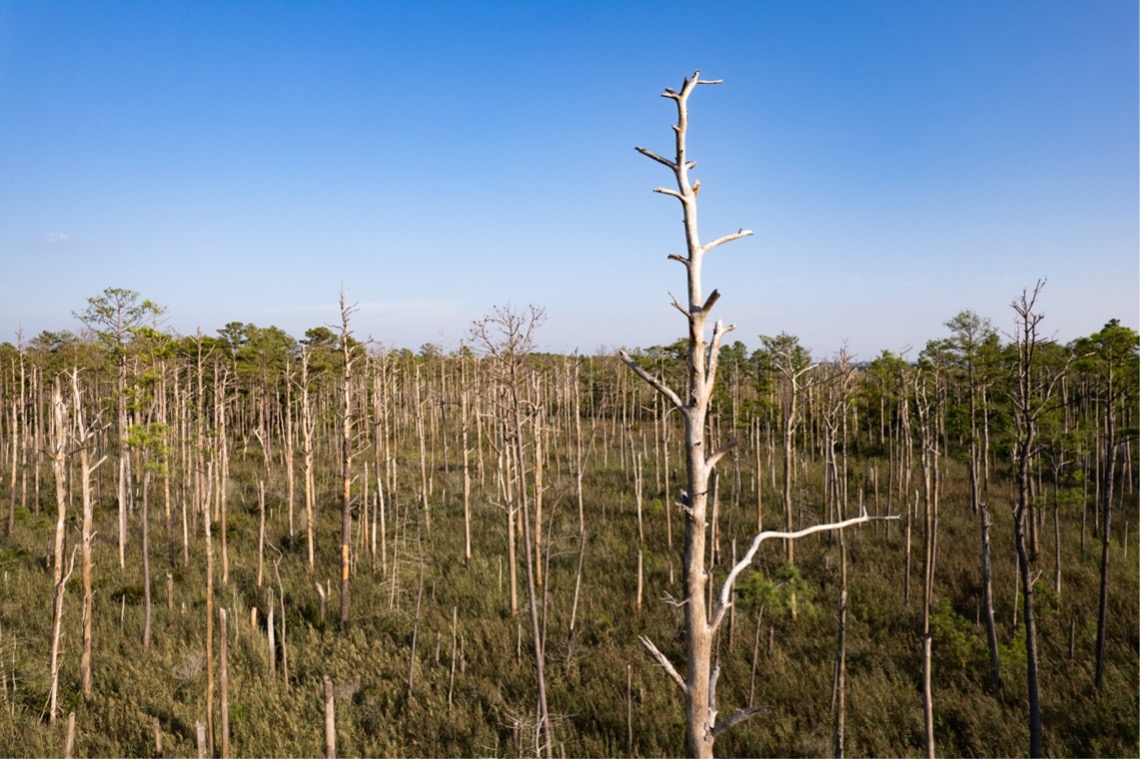
Growing up in Annapolis, I knew the Eastern Shore of Maryland very superficially, only passing by it on my way to the beach. When I reached high school and began to develop more interest in the natural sciences, I began to notice an odd sight. I’d drive by and see vast expanses of dead forests in the middle of the summer; a sight that left me concerned and curious. Driven by this newfound curiosity, I began to conduct more research and learned that the Eastern Shore was facing very serious threats stemming from climate change and sea level rise, and one such example of this was these “ghost forests” I saw in many parts of the Eastern Shore.
I set out to investigate this issue and speak to landowners and forestry experts while working for Maryland Sea Grant in 2021. I soon discovered that in addition to sea level rise, the eastern shore was also experiencing land subsidence. With the increased frequency of high-tides and storm events, and the flat topography of the land, water from the bay encroaches further inland, leaving the soil with a higher salinity content. This phenomenon is known as salt-water intrusion, and it is responsible for the loss of many thousands of acres of forest and agricultural land. I spoke to farmers along the many “necks” of the Chesapeake Bay and was shocked that I had not heard more about this growing up just 20 miles away in Annapolis. I realized that climate change had already left tangible consequences in my own backyard- it was no longer something I thought of exclusively in the future tense.
The eastern shore has a deep tradition of farming loblolly pines, which were traditionally harvested once a generation, and used to provide for the next. However, loblolly pine farmers that have been on their land for generations must now reckon with the reality of a changing climate. This has devastated the cultural and environmental heritage of these communities. With little opportunity for youth to continue in the ways of their parents, they leave for opportunity elsewhere. Speaking with Mike Calders, a third-generation loblolly pine farmer from Crapo, Maryland, I learned that many of these small farming communities are under threat of disappearing with an increasingly dwindling population. Calders’ own family property has seen a dramatic transition since the 1960s, with more than two thirds of the property transitioning from forest to marsh.
Speaking with Matt Hurd, a forester at the Maryland Forest Service, the future is focused on helping landowners manage and adapt to what is accepted as an inevitable change.
“We’re hoping to be able to do a lot of small things that just resist the change…and find ways for landowners to financially benefit from it, and therefore be engaged by it.”
Many landowners are incentivized to adapt their lands to new purposes, such as hunting and conservation, where partnerships with organizations such as Blackwater National Wildlife Refuge can provide landowners an economic escape from an otherwise frozen real estate market. Thus, conservation and other strategic partnerships can help facilitate transitions for landowners who may be struggling to adapt. The Eastern Shore constitutes about a third of Maryland’s land, yet less 10% of its population. Heavily dependent on agriculture, the Eastern Shore’s unique coastal topography will see the worst of the consequences of climate change, and will have serious impacts in forestry, agriculture, tourism, and more.
To learn more, readers may watch this documentary series I produced on the impacts of saltwater intrusion on the Eastern Shore. (Part 1, Part 2)
